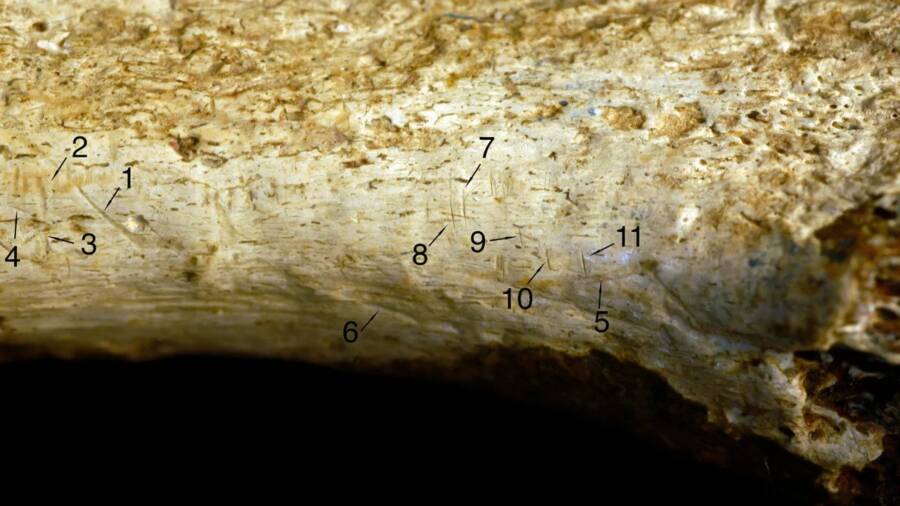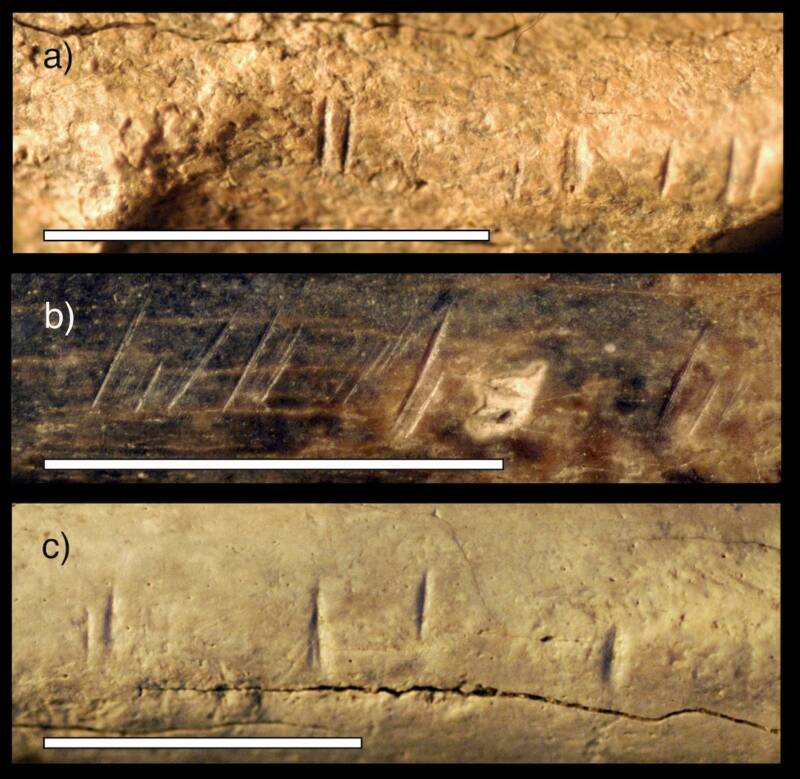The marks on the 1.5 million-year-old bone suggest that a stone tool was used to remove muscle from bone.

Jennifer ClarkScientists believe that nine of the 11 marks were made by stone tools; the other two were made by a lion-like animal.
Fifty years after the shinbone of a distant human relative was discovered in Kenya, a paleoanthropologist noticed something unsettling about tiny grooves on the bone’s surface. Briana Pobiner was looking for tooth marks left by animals when she noticed straight lines left by a tool, which suggested something else had gotten to the bone — another human.
“I was floored and shocked and went, ‘No way,'” Pobiner, the lead author of a new study on the bone and a paleoanthropologist at the National Museum of Natural History, told the Washington Post. She immediately looped in her colleagues, telling them: “Come here. Come look at this. Am I crazy?”
Indeed, the 1.45 million-year-old bone appeared to have been cut with stone tools, meaning that it could be the oldest evidence of human cannibalism ever found. The cut marks are all in the same direction, suggesting that the person wielded the stone tool without changing hands.
“These cut marks look very similar to what I’ve seen on animal fossils that were being processed for consumption,” Pobiner explained in a news release about the find. “It seems most likely that the meat from this leg was eaten and that it was eaten for nutrition as opposed to for a ritual.”
That said, Pobiner pointed out the bone marks are only cannibalism if the bone comes from the same human species that cut it up, and there were three known species living in the region where the bone was found 1.5 million years ago: Homo erectus, Homo habilis and Paranthropus boisei.
“You have to know who is doing the eating and who is being eaten, and in this case we know neither,” she told the Washington Post, noting that it’s difficult to determine a species with a single bone.

Briana PobinerA close up of the cut marks on the 1.45 million-year-old bone, which could be the earliest known evidence of cannibalism.
In addition to the stone marks, Pobiner and her colleagues also found other marks on the bone which appear to have been left by an animal. One of the study’s co-authors, Michael Pante of Colorado State University, created 3D computer models of the marks and determined that while nine were cut marks from a tool, two had come from a lion-like animal. But which came first?
The researchers aren’t sure if ancient humans killed the victim, who an animal then scavenged, or if an animal killed the victim, who ancient humans then cannibalized.
“It seems a bit unusual for a large feline like a lion to scavenge the remains of a [hominin] that has already had its deeper muscles exploited,” Antonio Rodríguez-Hidalgo of the Catalan Institute of Human Paleontology and Social Evolution (who did not participate in the study), told the Washington Post. “What would be left for the cats to scavenge? Only the marrow, but large cats are not known for their bone-cracking abilities, and the tibia appears to be intact. So, this scenario doesn’t seem very plausible.”
Whoever attacked first, Pobiner is still convinced that the stone cuts on the bone are indicative of human cannibalism.

Jennifer ClarkHow this ancient human ancestor initially died is unclear, as its shinbone bears marks of both bone stone tools and animal teeth.
“The information we have tells us that hominins were likely eating other hominins at least 1.45 million years ago,” she said. “There are numerous other examples of species from the human evolutionary tree consuming each other for nutrition, but this fossil suggests that our species’ relatives were eating each other to survive further into the past than we recognized.”
In other words, cannibalism among humans could have a long history. And though gruesome, that history could tell us a lot about prehistoric societies.
“[C]annibalism in Homo sapiens carries deeper philosophical implications,” Rodríguez-Hidalgo noted. “It raises questions about love versus hate, family versus enemy, war cannibalism versus mortuary cannibalism, and feast versus famine.”
After reading about how scientists possibly found the earliest evidence of human cannibalism on a 1.45 million-year-old bone, look through these terrifying accounts of human cannibalism. Or, see how the infamous Donner Party got trapped in the mountains en route to California and resorted to cannibalism in order to survive.





